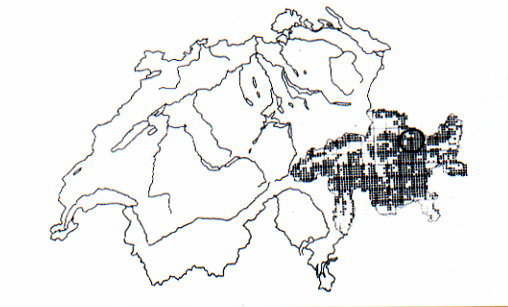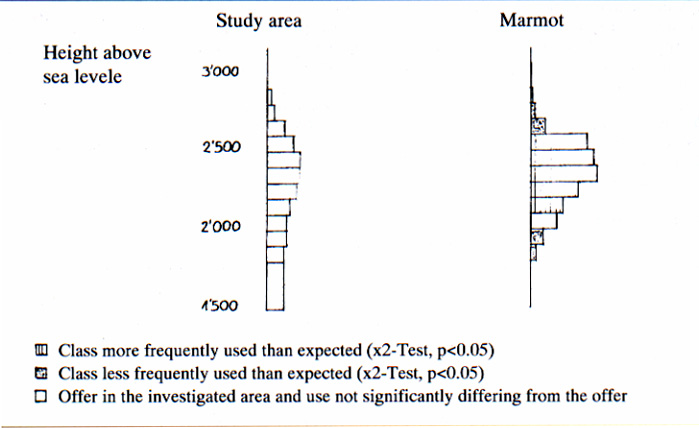

ritorno/back
HABITAT SELECTION OF Marmota marmota IN THE EASTERN ALPS OF SWITZERLAND
Müller J.P.
PhD Bundner Natur-Museum, CH-7000 Chur / Switzerland
Abstract - Marmota marmota is widely distributed in the study area. It is only lacking where human settlements are found, in the fertilized meadows lower down and in the forest. The serpentin area on the Totalp is very sparsely inhabited. The marmot can be found at heights between 1800 and 2900 metres above sea level, most of them being found between 2100 and 2600. Southerly slopes are generally not preferred. The marmot may be found in nearly all types of vegetation above timberline. The complexity of the vegetation is very important for the occurrence of the marmot. In the study area the marmot has only been marginally influenced by tourism.
AIM OF THE STUDY
Description of the environmental factors, which characterise the habitat of Marmota marmota in large connected areas with a comparatively dense marmot population.
General description of the influence of the land use by man on the marmot's presence and distribution (MAB - Man and Biosphere Programme).
STUDY AREA (Fig. 1)
The area near Davos (Circle), which was investigated, is situated in the very extended population of marmots in the Swiss canton of the Grisons and has a total surface of 82 km2. Map from Mueller 1986. The distribution shown on this map is based on 2 x 2 km grids.
METHODS
As a result of systematic observations and mapping of burrows during the summer of 1982, 50 x 50 m grids were marked with: presence of marmots yes/no. Number of grids in the investigated area: 32'800. Specialists of MAB-programmes registered in detail the environmental factors and different forms of land use on all the grids. In this study, it was most important, non-only to describe the environmental factors at the places, where Marmota marmota was found, but to find out the habitat selection out of a given offer.
RESULTS
The following graph concerning Marmot distribution and altitude may give an example of the kind of the results.
The detailed results concerning Marmot distribution in relation to factors such as altitude, steepness of slope, exposure, vegetation (63 units), duration of snow cover, occurrence of other herbivores and land use by man will be published in a separate publication (Mueller, in preparation).
SELEZIONE DELL'HABITAT DA PARTE DI Marmota marmota NELLE ALPI ORIENTALI DELLA SVIZZERA
Müller J.P.
PhD Bundner Natur-Museum, CH-7000 Chur / Switzerland
Scopo dello studio
Descrizione dei fattori ambientali che caratterizzano l'habitat di Marmota marmota in ampie aree con densità di marmotte relativamente alta.
Descrizione generale dell'influenza dell'uso del territorio da parte dell'uomo sulla presenza e distribuzione delle marmotte (MAB - Programma Uomo e Biosfera).
Area di studio (Fig. 1)
L'area di studio (cerchio), attorno a Davos é situata all'interno dell'ampia popolazione di marmotte nel cantone svizzero dei Grigioni ed ha una superficie di 82 Kmq.
La carta é tratta da Mueller (1986). La distribuzione presentata sulla carta si basa su una griglia di2x2Km.
Metodi
A seguito di osservazioni sistematiche e della marcatura delle tane durante l'estate del 1982, l'area é stata suddivisa in quadrati di 50x50 metri e per ciascun quadrato é stata indicata la presenta/assenza delle marmotte. Il numero di quadrati analizzati é di 32.800.Specialisti di programmi MAB hanno registrato in dettaglio i fattori ambientali e le differenti forme di uso del territorio in tutti i quadrati. In questo studio era importante non solo descrivere i fattori ambientali nei siti dove le Marmota marmota erano presenti ma di mettere in evidenza la selezione dell'habitat rispetto all'offerta.
Risultati
Il grafico riguardante la distribuzione delle marmotte e dell'altitudine può fornire un'indicazione del tipo di risultati ottenuti. I risultati dettagliati riguardo la distribuzione delle marmotte in relazione a fattori quali altitudine, pendenza, esposizione, vegetazione (63 unita), durata della copertura nevosa, presenza di altri erbivori, ed uso umano del suolo saranno pubblicati separatamente in futuro (Mueller, in preparazione).


REFERENCES
MUELLER, J. P. (1986): Das Murmeltier. Disentis: Desertina Verlag.
MUELLER, J.P., ACKERMANN, G., JENNY, H. (1988): Die Lebenshedingungen ausgewahlter Wildtierarten im MAB-Testgebiet Davos. Schlussberichte zum Schweizerischen MAB-Programm, Nr. 34, Bem.
Â